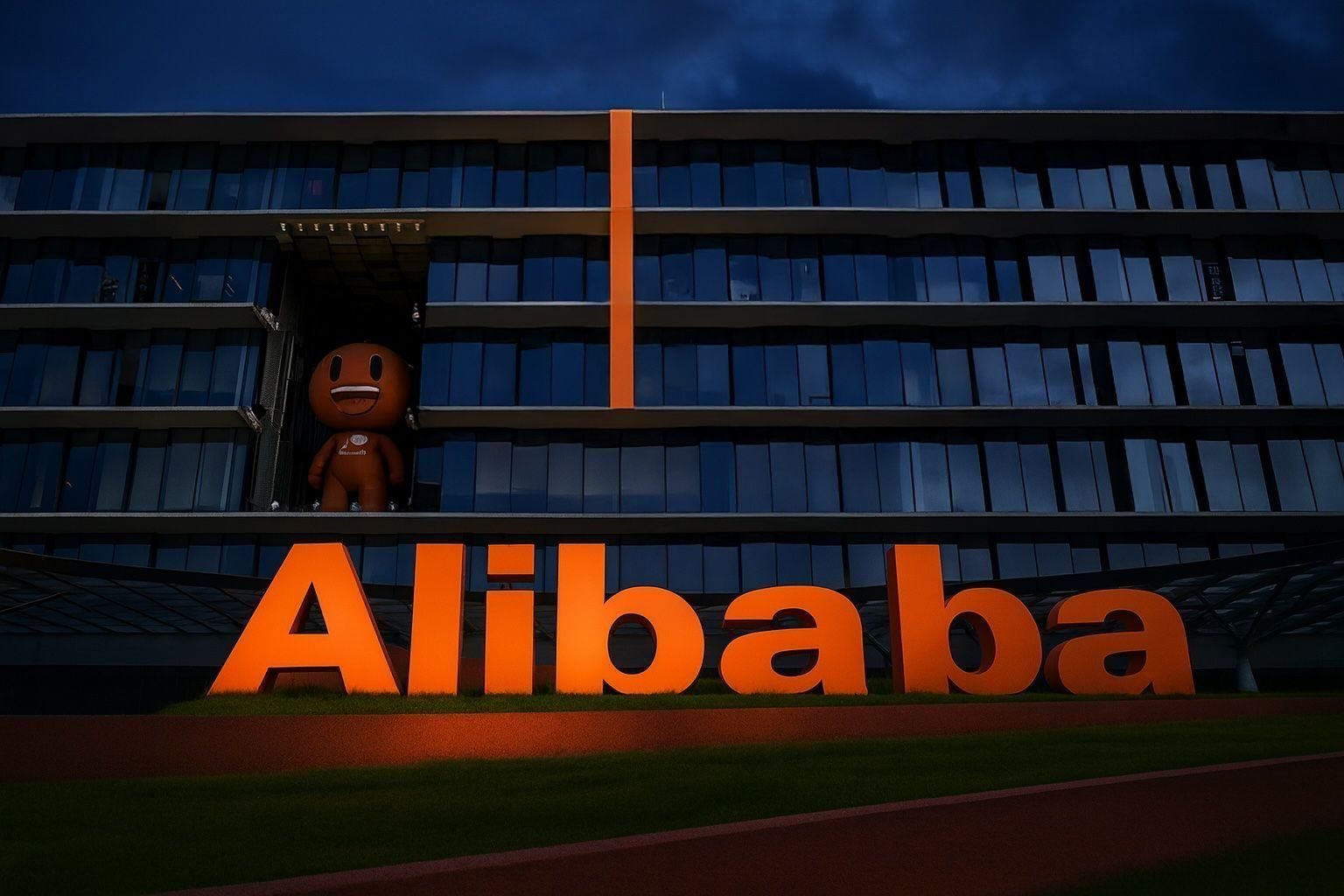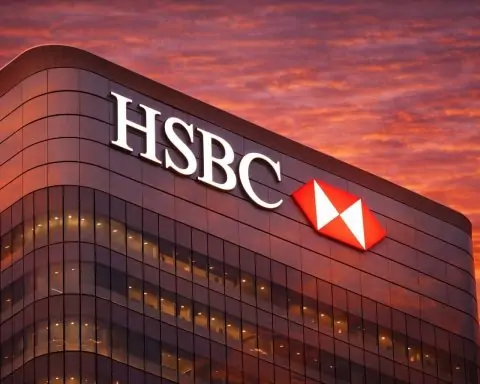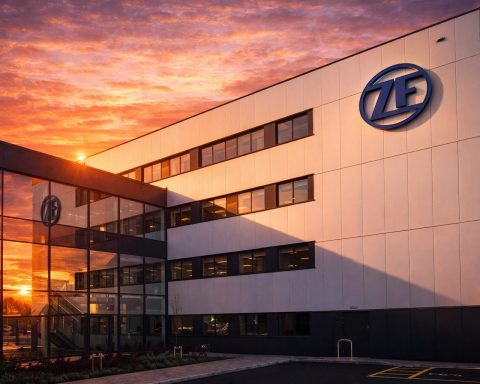Alibaba Group Holding Ltd. (NYSE: BABA) is trading roughly flat today as investors juggle a complicated mix of headlines: a fresh Pentagon watchlist scare, a powerful AI and cloud growth story, brutal “instant retail” price wars, and new AI hardware in the form of Alibaba’s Quark smart glasses.
BABA stock price today: near $157 after an 86% YTD surge
In Friday trading, Alibaba’s U.S.-listed shares are changing hands at around $157 per share, just a touch below yesterday’s close of $157.60. Intraday, the stock has traded in a tight range around $155.7–$158.7, leaving it essentially unchanged on the day. [1]
Despite the muted move today, the year-to-date picture is much more dramatic. Over the last 12 months, BABA has:
- Rallied roughly 86% YTD, according to FinanceCharts data.
- Traded between a 52‑week low of about $80 (January 13, 2025) and a 52‑week high near $193 (October 2, 2025). [2]
At this price, Alibaba sits in the upper half of its 52‑week range but well below its recent high, reflecting a sharp recovery from early‑2025 pessimism without reaching full “euphoria” levels.
On the Hong Kong line (9988.HK), Alibaba’s shares closed around HK$151.5, up modestly on the session, roughly mirroring the sideways tone in New York. [3]
Wall Street view: Strong Buy consensus, but one big “Strong Sell”
The analyst community is split in a way that’s frankly pretty rare:
- Aggregated broker and platform data still point to a “Strong Buy” consensus, with an average 12‑month price target in the $189–$197 range, implying roughly 20–25% upside from today’s levels. [4]
- By contrast, Zacks currently assigns Alibaba a Rank #5 (Strong Sell), citing collapsing profitability metrics and negative free cash flow after the latest quarter. [5]
Valuation‑wise, Simply Wall St estimates a DCF “fair value” around $265 per share, about 40% above the current price, and notes that BABA trades at a P/E of ~19.9×, slightly below its own “fair” multiple estimate (~29.7×) and well under some global peers. [6]
So, depending on which model you favor, Alibaba is either:
- A still‑cheap AI leader with 20–40% upside, or
- A stock with stretched valuation given the pressure on cash flows and margins.
Welcome to modern equity research, where two spreadsheets can disagree loudly.
Today’s big theme #1: Pentagon watchlist fears return
The headline spooking some investors this week — and still hanging over the stock today — is a report that the U.S. Department of Defense may add Alibaba to its “1260H” list, a Pentagon watchlist of Chinese companies alleged to have ties to the military. [7]
Key points:
- Reports suggest Alibaba, Baidu and BYD could be added to the 1260H list, which designates “Chinese military companies” under U.S. law. [8]
- The list itself does not automatically impose sanctions, but historically it has paved the way for investment restrictions and heightened political risk, especially for U.S. investors.
- Barron’s notes that the renewed watchlist talk rekindles memories of earlier U.S. clampdowns on Chinese tech, though Alibaba’s shares have proven surprisingly resilient so far. [9]
Interestingly, Morgan Stanley — whose research note was cited in Hong Kong media on the same topic — has reiterated its Overweight rating on Alibaba despite the 1260H headlines, suggesting the bank sees the watchlist risk as manageable relative to the upside from AI and cloud. [10]
In short: regulatory overhang is back on the front burner, but the market is not pricing in a worst‑case scenario yet.
Today’s big theme #2: AI and cloud are the bright spots
On the positive side, AI and cloud remain the beating heart of the bull case — and that’s exactly where today’s newer headlines are clustered.
A quarter where AI and cloud outshone profits
On November 25, Alibaba reported results for the quarter ended September 30 (its fiscal Q2 2026). The numbers were a study in contrast:
- Revenue: 247.8 billion yuan (≈ $35 billion), up 5% year‑on‑year and beating analyst expectations of about 242.7 billion yuan. [11]
- Net profit: plunged 53% to 20.6 billion yuan, as Alibaba poured cash into AI infrastructure and its one‑hour delivery push. [12]
- Cloud Intelligence Group: revenue jumped 34% year‑on‑year to 39.8 billion yuan, with adjusted EBITA up 35% to 3.6 billion yuan. [13]
Reuters’ Breakingviews described it as an “AI feast” with some indigestion from the “food wars”: Alibaba now commands roughly 36% of China’s AI cloud market, more than ByteDance, Huawei and Tencent combined, according to Omdia. [14]
The company earlier pledged 380 billion yuan (≈ $54 billion) over three years to AI and cloud investments, and CEO Eddie Wu has hinted that this figure may end up being “on the small side” if customer demand keeps accelerating. [15]
Today’s AI headlines: “Top AI enabler” and AI‑powered sourcing
Two fresh pieces of news today reinforce the AI story:
- Morgan Stanley survey: Alibaba as China’s top AI enabler
A new Morgan Stanley survey cited by Yahoo Finance ranks Alibaba as China’s leading AI enabler, reflecting its strength in AI‑ready cloud infrastructure, large language models (Qwen), and developer tools. [16] - Procurement & sourcing: AI across the B2B stack
Procurement Magazine highlights how Alibaba’s AI‑powered sourcing platform — spanning product search, ordering, payments, logistics and after‑sales — is helping it surpass quarterly revenue expectations while deepening relationships with small and mid‑sized businesses globally. [17]
The broader takeaway: Alibaba isn’t just building AI for its own apps; it’s trying to be the plumbing for other companies’ AI‑driven commerce. That’s exactly the kind of “picks and shovels” role markets tend to reward over long cycles.
Today’s big theme #3: Brutal “instant retail” and food‑delivery price wars
All that AI glory comes with a pretty nasty hangover: China’s instant retail and food‑delivery price war, which is hammering profitability across the sector.
Meituan’s loss shows the cost of the fight
Today, competitor Meituan reported its first quarterly loss since 2022, posting an adjusted net loss of 16 billion yuan for the September quarter as it battles Alibaba and JD.com on subsidies and one‑hour delivery. [18]
- Meituan explicitly blamed an overheated price war and warned of further losses next quarter.
- Reuters notes that Alibaba has ramped up its own instant retail push, broadening one‑hour delivery beyond groceries into more categories, amplifying the cash burn for everyone involved. [19]
Alibaba itself has admitted that:
- Operating income cratered about 85% in the latest quarter, as heavy instant‑retail subsidies and AI capex crushed margins. [20]
- It sees instant retail eventually adding up to 1 trillion yuan in annualized gross merchandise value over the next three years, but is still in the investment phase. [21]
- Unit economics are improving — management says cost per order in quick commerce has halved since the summer — yet overall cash generation remains under pressure, with operating cash flow and free cash flow sharply lower or even negative, as Zacks highlighted. [22]
Bloomberg, via Business Standard, characterizes this as a “two‑speed” Chinese economy inside Alibaba itself:
- Fast lane: cloud and AI, growing above 30% with improving profitability.
- Slow lane: consumer commerce, where intense competition and cautious Chinese households keep margins thin and cash flow volatile. [23]
For investors watching BABA today, Meituan’s results underline that instant retail is still a money pit across the industry, not just for Alibaba.
Today’s big theme #4: New Quark AI glasses — symbolic more than financial (for now)
Alibaba has also stepped into AI hardware with the launch of Quark AI Glasses, a wearable device integrating its generative AI capabilities.
- The glasses, launched in China, are designed as productivity and information companions, putting Alibaba’s Qwen‑based AI assistant into a lightweight headset form factor. [24]
- Coverage from AskTraders this morning notes that BABA’s share price barely budged on the news, with pre‑market trading only modestly lower — a “mild reaction” that suggests investors view the glasses as strategic signaling rather than a near‑term earnings driver. [25]
Strategically, the device matters because it:
- Showcases Alibaba’s AI stack in a consumer‑facing product, an area where it has historically lagged ByteDance and others. [26]
- Fits with Alibaba’s recent launch of a free consumer AI app built on Qwen, which topped 10 million downloads in its first week. [27]
But from a stock perspective, today’s Quark news is more about narrative than numbers.
Today’s big theme #5: Hedge funds and institutions reshuffle positions
Beneath the headlines, there’s also slow but steady institutional repositioning:
- Insider Monkey’s list of “10 AI Stocks Making Headlines on Wall Street” today features Alibaba, noting that Benchmark reiterated its Buy rating with a $195 price target after the earnings release, highlighting 5% revenue growth, 34% cloud acceleration and 16% growth in China e‑commerce. [28]
- MarketBeat reports that smaller U.S. advisory firms such as Quadrant Capital Group LLC and GM Advisory Group LLC have recently added or increased BABA positions, signaling continued interest from long‑only investors even after the big YTD rally. [29]
Meanwhile, the Zacks/Nasdaq note leans the other way, arguing that:
- Adjusted EBITDA fell about 78%,
- Operating cash flow dropped around 68%, and
- Free cash flow swung to a ~22 billion yuan outflow due to ~32 billion yuan of capex,
and concludes that the stock now trades at a premium price‑to‑sales multiple relative to its internet‑commerce peers. [30]
So, even today, you can find smart money on both sides of the trade.
How cheap (or expensive) is Alibaba stock today?
Here’s how today’s valuation picture stacks up using current data:
- Share price: ≈ $157–158
- Market cap: around $350–375 billion. [31]
- Trailing P/E: roughly 21–22×, with a forward P/E just over 20×, per StockAnalysis. [32]
- Analyst targets:
- DCF‑style fair value (Simply Wall St): about $265, implying ~40% undervaluation. [36]
On the other hand:
- Zacks warns that profitability, cash flow and margins are deteriorating far faster than revenue is growing, and it gives BABA a Zacks Rank: Strong Sell. [37]
Put bluntly: Alibaba looks cheap on many long‑term fundamental and AI‑growth metrics — but expensive if you think the current margin squeeze and cash‑burn phase will last longer than bulls expect.
Key risks investors are focused on today
From the lens of November 28, 2025 trading, several risks are front‑of‑mind:
- U.S. security and regulatory risk
- Potential inclusion on the Pentagon’s 1260H watchlist could eventually lead to tighter investment curbs or reputational damage, even if no immediate sanctions arrive. [38]
- Margin compression and cash‑flow stress
- The combination of AI capex and quick‑commerce subsidies has crushed operating income (‑85% YoY) and flipped free cash flow negative in the latest quarter. [39]
- Hyper‑competitive domestic landscape
- Meituan’s loss today and JD.com’s push into delivery and electronics signal that China’s consumer internet battlefield is still intensifying, not calming. [40]
- China macro and policy uncertainty
- Bloomberg’s “two‑speed” frame — strong digital infrastructure demand versus sluggish traditional consumption — highlights that Alibaba’s exposure to Chinese consumers is still a double‑edged sword. [41]
What to watch next for BABA after today
For traders and longer‑term investors tracking Alibaba from here, the main forward‑looking questions are:
- Does the Pentagon 1260H story escalate?
Any formal announcement or follow‑up measures from U.S. agencies would likely hit sentiment much harder than today’s rumors and research notes. - Can Alibaba turn AI investment into visible profit growth?
The company is clearly becoming a top‑tier AI infrastructure player in China, with leading cloud AI share and strong model performance. The next test is whether that translates into sustained, high‑margin revenue growth rather than just capex‑heavy momentum. [42] - When do instant‑retail price wars cool down?
Meituan’s blow‑out loss and management’s complaints that the price war is “unsustainable” hint that industry‑wide rationalization could come as soon as 2026. If subsidies fade, Alibaba’s cash flow and margins could rebound faster than current bear cases assume. [43] - Will the analyst split resolve?
Over the next few quarters, either the bullish price targets near $190–$200 or the Zacks “Strong Sell” narrative will get validated by the numbers. Right now the market price is sitting right in the middle of those competing stories.
Bottom line on Alibaba stock today
On November 28, 2025, Alibaba stock is:
- Trading quietly around $157,
- Up ~86% year‑to‑date, yet still well below its recent high,
- Pulled upward by AI and cloud strength plus broadly bullish Street targets,
- Pulled downward by Pentagon watchlist fears, brutal instant‑retail competition, and real pressure on profitability and cash flow. [44]
It is not a low‑drama stock — it’s a complex, high‑beta bet on Chinese tech, AI infrastructure, and regulatory détente. Anyone looking at BABA today is effectively taking a view on all three at once.
This article is for informational and educational purposes only and does not constitute investment advice, a recommendation, or a solicitation to buy or sell any securities. Always do your own research and consider your financial situation and risk tolerance before making investment decisions.
References
1. www.investing.com, 2. www.financecharts.com, 3. www.marketscreener.com, 4. www.investing.com, 5. www.nasdaq.com, 6. simplywall.st, 7. www.barrons.com, 8. www.aastocks.com, 9. www.barrons.com, 10. www.aastocks.com, 11. www.reuters.com, 12. www.reuters.com, 13. www.reuters.com, 14. www.reuters.com, 15. www.reuters.com, 16. finance.yahoo.com, 17. procurementmag.com, 18. www.reuters.com, 19. www.reuters.com, 20. www.reuters.com, 21. www.reuters.com, 22. www.reuters.com, 23. www.business-standard.com, 24. www.asktraders.com, 25. www.asktraders.com, 26. procurementmag.com, 27. www.reuters.com, 28. www.insidermonkey.com, 29. www.marketbeat.com, 30. www.nasdaq.com, 31. stockanalysis.com, 32. stockanalysis.com, 33. stockanalysis.com, 34. www.investing.com, 35. www.marketbeat.com, 36. simplywall.st, 37. www.nasdaq.com, 38. www.barrons.com, 39. www.reuters.com, 40. www.reuters.com, 41. www.business-standard.com, 42. www.reuters.com, 43. www.reuters.com, 44. www.financecharts.com







